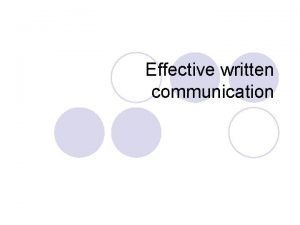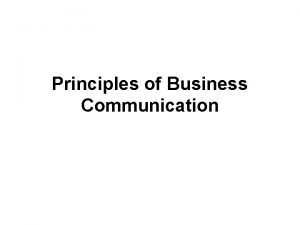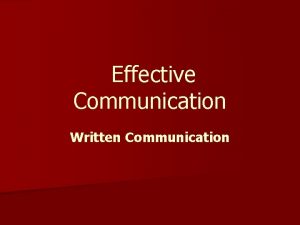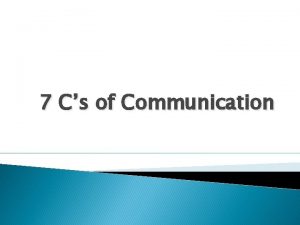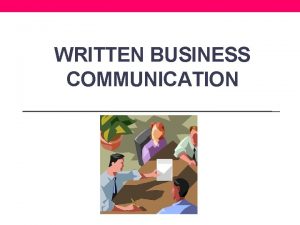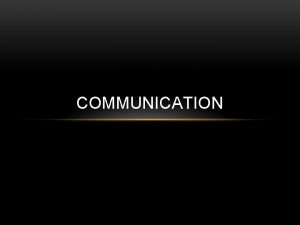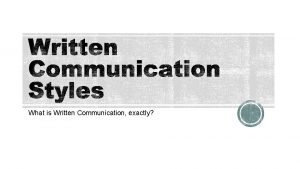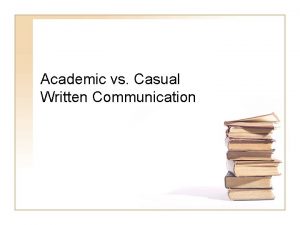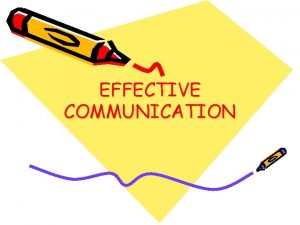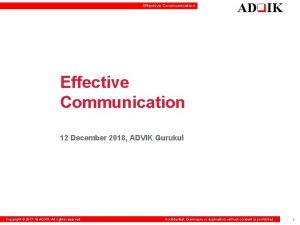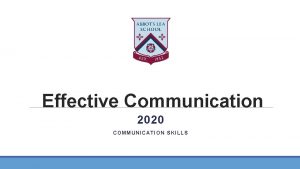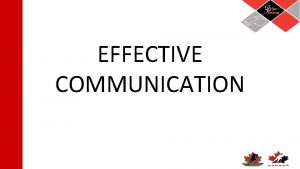Effective Written Communication The use of written communication






















- Slides: 22

Effective Written Communication

The use of written communication When to write How to write

Factors involved in the choice of written channel • • Complexity of the topic Amount of discussion required Shades of meaning Formal communication

1 - Complexity of the topic Written channel is better option for the messages which are: Easily Organized Easily understood

2 -Amount of discussion Written communication is not preferable for the issues that require lengthy discussion.

Decision making Conversations Controversial subjects

3 - Shades of meaning Written communication lacks 1 - Tone of voice 2 - Body language

We have to rely on words to convey the different shades of meaning

Difficult to convey Humor Irony Satire

4 -Formal communication Written channel is a better choice when the level of formality is high

• Paper communication • Emails • Telephonic conversation • Face-to-face

Examples: • Contract terms • Sales agreement • Account information • Legal issues

How to write effectively • Writing a letter or an email includes: 1 -Subject line 2 - Putting the main point at the top 3 - Knowing your audience 4 - Organization of the message

1 -Subject line • It tells us about the information that will follow. Examples: (General) Response to your Email Question Hello Meeting Urgent

Subject Line Examples: (Specific) Response to your query about scholarship Questions regarding fitness Hello! Come today in my office Meeting with the parents Urgent replacement in duties

2 -Putting the Main Point • The main point of communication is better to be placed first because: 1 - We often scan written material to save time. 2 - We focus more at the top of the message. 3 - We often take no further notice if background information is given at the start.

3 -Knowing your audience It helps you target and tune the communication

Your audience may be: • General • Particular

Awareness of what your audience • Know • Don’t know

4 -Organization of the message

Written communication may have • Multiple messages unrelated to one another • Several messages within the main message related to one another

Subtopics are treated with their headings
 Objectives of written communication
Objectives of written communication Effective written communication
Effective written communication Principles of business communication
Principles of business communication What is oral communication and written communication
What is oral communication and written communication Difference between oral and written communication
Difference between oral and written communication Writing effective use cases by alistair cockburn
Writing effective use cases by alistair cockburn The art of using language effectively
The art of using language effectively Effective use of ohp
Effective use of ohp Facilitation style in teaching
Facilitation style in teaching Maritime energy conservation
Maritime energy conservation What is the study or art of using language effectively?
What is the study or art of using language effectively? Hình ảnh bộ gõ cơ thể búng tay
Hình ảnh bộ gõ cơ thể búng tay Frameset trong html5
Frameset trong html5 Bổ thể
Bổ thể Tỉ lệ cơ thể trẻ em
Tỉ lệ cơ thể trẻ em Voi kéo gỗ như thế nào
Voi kéo gỗ như thế nào Tư thế worm breton
Tư thế worm breton Hát lên người ơi alleluia
Hát lên người ơi alleluia Môn thể thao bắt đầu bằng từ chạy
Môn thể thao bắt đầu bằng từ chạy Thế nào là hệ số cao nhất
Thế nào là hệ số cao nhất Các châu lục và đại dương trên thế giới
Các châu lục và đại dương trên thế giới Cong thức tính động năng
Cong thức tính động năng Trời xanh đây là của chúng ta thể thơ
Trời xanh đây là của chúng ta thể thơ

